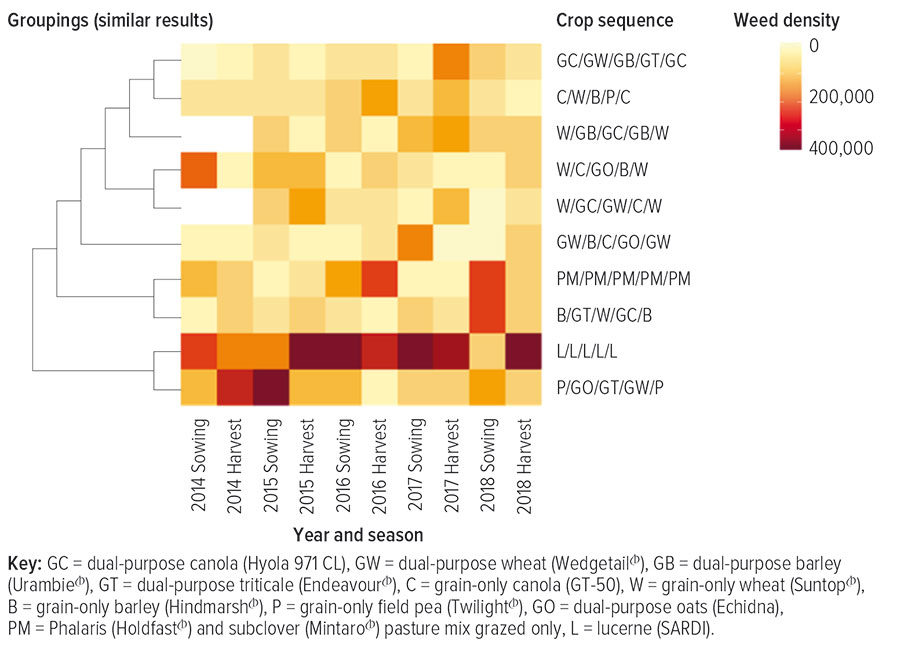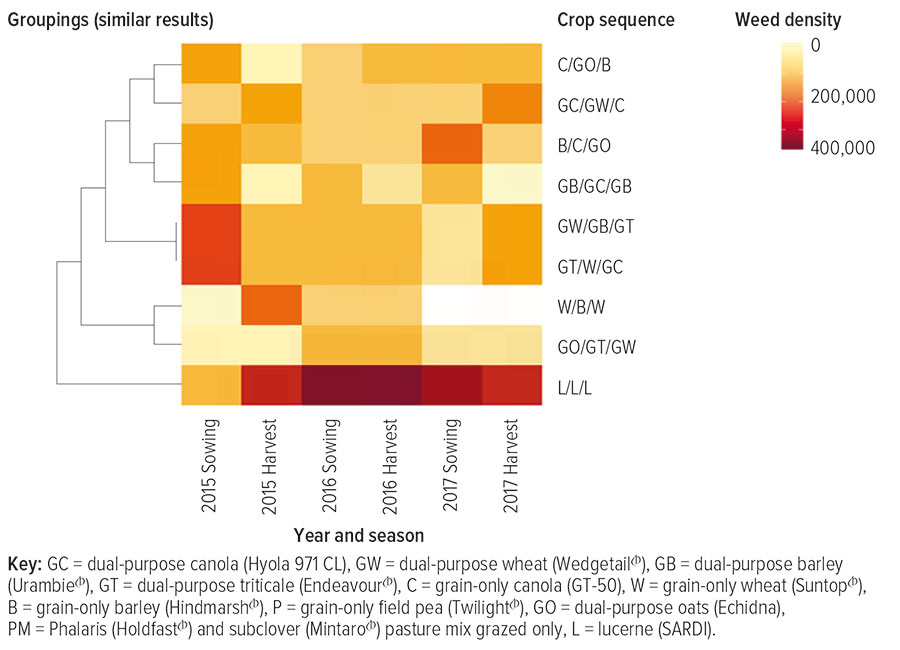Experiments confirm high-biomass crops capable of providing early season ground cover across multiple seasons can successfully drive down weed seed populations.
Dr Saliya Gurusinghe, a research fellow at Charles Sturt University (CSU), says the long term experiments were set up at two New South Wales locations to measure the effect of various crop rotations on driving down the weed seed bank.
“Our research showed different crop sequences and seasonal conditions altered the density and composition of problematic annual weeds in the soil,” Dr Gurusinghe says.
“Growing high-biomass crops with the capacity to out-compete weeds over multiple seasons can reduce weed density.
“Generally, our research demonstrated it was better to rotate paddocks with a different high-vigour crop species in successive seasons rather than the same crop type every year.”
The findings of the Graham Centre for Agricultural Innovation research – a partnership between CSU and the NSW Department of Primary Industries – arise from an analysis of nine years of combined experimental results from Wagga Wagga and Condobolin, NSW.
The experiments – set up by former CSU researcher Dr William Brown under the supervision of CSU research professor Leslie Weston – explored the legacy effects of the previous crop in various rotation sequences across multiple seasons. This was done by monitoring weeds in replicated plots before sowing and after harvest each year.
The research, performed with GRDC co-investment, demonstrates how different crop and pasture sequences change weed density in mixed-farming systems.
Competitive crops
Professor Weston says competitive annual crops compete with vigorous annual weeds through enhanced competition for resources including sunlight, water and nutrients.
“In addition, interference mediated by the physical presence of crop residues or the production and release of phytotoxic secondary plant metabolites in decomposing plant residues or through their exudation into the interface between plant roots and the soil can sometimes contribute to reduced weed establishment,” Professor Weston says.
“Development of cultivars or crop residues with an enhanced ability to interfere with weed growth presents potential additional and cost-effective control options for management of difficult-to-control weeds.”
A novel aspect of the research, Professor Weston says, is the effects of crop rotation on the diversity and density of weeds in eastern Australian mixed farming systems.
Research details
Under investigation were different crops in sequence (see Figures 1 and 2 below) including:
- grain-only and dual-purpose wheat;
- grain-only and dual-purpose barley;
- dual-purpose oats;
- grain-only and dual-purpose canola;
- field peas;
- a pasture mix of subterranean clover and Phalaris, and;
- a monoculture of perennial lucerne.
Except for the perennial lucerne, all annual species were rotated each year. All crops were sown with a tyned rig set on 20-centimetre row spacings. A knockdown glyphosate treatment was applied at the start of all experiments.
Appropriate agronomy was used across all years, with some practical differences according to crop type and location. Preemergent herbicides were used across all annual crop rotations.
The replicated plots were harvested during late November and the stubble was left undisturbed until planting in the following season.
At both locations, soil samples were taken to collect weed propagules (seeds or vegetative matter) to determine the weed density before sowing and after harvest. Treatment means from the replicated plot trials were compared using standard statistical tests.
Heat maps were then generated to demonstrate the variation in weed seed density.
Climatic conditions
At Wagga Wagga, March-to-November rainfall in 2014, 2017 and 2018 was significantly less than the long-term growing season average of 442 millimetres (389, 312 and 278mm, respectively).
However, in 2015 and 2016, growing season rainfall exceeded the long-term average with 503 and 651mm recorded, respectively.
At Condobolin, March-to-November rainfall in 2015 (332mm), 2016 (561mm) and 2017 (395mm) exceeded the mean of 325mm.
Weed diversity
Dr Gurusinghe says weed species diversity was nearly uniform at Wagga Wagga and Condobolin at the start of each experiment. “Our analysis across both locations showed about 30 different weed species,” he says.
“The top 10 most prevalent weeds in each treatment were ranked and included both environmental and agronomic weeds of importance.”
Of the agronomic weeds, winter-active annual ryegrass (Lolium rigidum) and summer-active hairy panic (Panicum species) dominated.
Broadleaf weeds such as flaxleaf fleabane, common sowthistle, pigweed and fumitory were found in the weed seedbank in most crop rotations and ranked in the top 10 most abundant weed species.
Overall results
Dr Gurusinghe says overall, the density of annual winter and summer weeds was reduced in seasons with average to above-average rainfall conditions due to crop competitiveness against weeds, resulting in reduced weed establishment.
“By contrast, limited rainfall resulted in a dramatic and significant rebound in weeds in the following season due to a lack of crop competition,” he says.
“Several crop sequences were effective in suppressing weeds over time, confirming that crop rotation is one of the most important cultural practices for integrated weed management.”
Wagga Wagga results
At Wagga Wagga, Dr Gurusinghe says the two most weed-competitive crop sequences were the non-grazed canola/wheat/barley/field pea/canola sequence and the dual- purpose canola/dual-purpose wheat/dual-purpose barley/dual-purpose triticale/dual-purpose canola rotation.
“These two rotations reduced the weed seedbank by about 50 per cent compared to the least weed-competitive treatment, the monoculture of lucerne,” he says.
Figure 1: Sowing and harvest weed density at Wagga Wagga, New South Wales.
This figure presents the density of weeds measured at harvest and at sowing over five years. A lighter colour indicates a lower density of weeds, compared with the darker colour, which has a heavier density of weeds. For example, after five years, the canola/wheat/barley/field pea/canola sequence and the dual-purpose canola/dual-purpose wheat/dual-purpose barley/dual-purpose triticale/dual-purpose canola sequence clustered together with the lowest density of weeds, compared with the monoculture of lucerne.

Source: Saliya Gurusinghe, Shamsul Haque, Agasthya Totagamuwa, Paul Weston, William Brown, Graeme Heath and Leslie Weston, Charles Sturt University, 2022
Condobolin results
At Condobolin, Dr Gurusinghe says all annual crop rotations reduced weed density over the three years when compared with the lucerne monoculture (see Figure 2).
Figure 2: Sowing and harvest weed density at Condobolin, New South Wales.
The figure presents the density of weeds measured at harvest and at sowing over three years. This study was reduced to three years because of flooding at the trial site. A lighter colour indicates a lower density of weeds, compared with the darker colour, which has a higher density of weeds. After three years, all annual crop rotations reduced weed density, when compared with the monoculture of lucerne. The GO/GT/GW and W/B/W sequences clustered together with the lowest density of weeds. All other rotations clustered together, indicating similar densities of weeds over the duration of the experiment.

Source: Saliya Gurusinghe, Shamsul Haque, Agasthya Totagamuwa, Paul Weston, William Brown, Graeme Heath and Leslie Weston, Charles Sturt University, 2022
“The dual-purpose oats/dual-purpose triticale/dual-purpose wheat rotation and the wheat/barley/wheat sequence had the lowest number of weeds,” he says.
“Other rotations had similar weed densities over the duration of the experiment.”
Putting it together
Dr Gurusinghe says the study confirms diverse sequences of high-biomass cereal, canola and pulse crops can reduce the weed seedbank.
“These results suggest that annual weed emergence and the resulting seedbank may be further depleted through more-competitive wheat, oat, barley and canola cultivars,” he says.
“The non-grazed rotation – canola/ wheat/barley/field pea/canola – at Wagga Wagga maintained a dense weed-competitive canopy that shaded the soil surface.
“A mat of retained residue from previous crops also keeps the soil cooler and may further suppress weed seed emergence.
“Anything that reduces canopy closure and ground cover in crops or leads to patchy crop or pasture establishment and poor crop or pasture persistence allows weeds to establish.”
In the pasture mix and the lucerne monoculture, Dr Gurusinghe says the addition of nitrogen from the legumes and the lack of ground cover meant that summer weeds established and thrived.
“Crop and pasture competition with weeds is a combination of the above-ground shoot and below-ground root interactions,” he says.
“Also, since livestock graze selectively, aim to prevent overgrazing, for example through the use of either electric fencing or with containment feeding areas to maintain ground cover and minimise weed establishment in overgrazed areas."
Dr Gurusinghe says using multiple weed management tactics is critical because the study demonstrated reducing the weed population by relying on crop rotation alone can take up to three years.
“It’s important to use multiple tactics to minimise weed emergence and seed set as weeds can continually invade from elsewhere," he says.
"These tactics include crop rotation, applying herbicides at label rates, using high seeding rates, sowing crops on narrow row spacings and employing harvest weed seed control.”
More information: Saliya Gurusinghe, sgurusinghe@csu.edu.au; Leslie Weston, leweston@csu.edu.au

























































